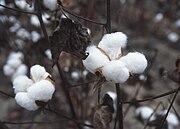Organic cotton

| Cotton |
|---|
 |
| History |
| Terminology |
|
| Types |
| Production |
| Fabric |
| Part of a series on |
| Clothing and the environment |
|---|
| Environmental impact of fashion |
Organic cotton is generally defined as
As of 2007[update], 265,517 bales of organic cotton were produced in 24 countries and worldwide production was growing at a rate of more than 50% per year.
Ecological footprint
Cotton covers 2.5% of the world's cultivated land but uses 10-16% of the world's pesticides (including herbicides, insecticides, and defoliants), more than any other single major crop.[4][7] Environmental consequences of the elevated use of chemicals in the non-organic cotton growing methods include the following:
- Chemicals used in the processing of cotton pollute the air and surface waters.
- Decreased biodiversity and shifting equilibrium of ecosystems due to the use of pesticides.[8]
As is the case for any comparison between organic and "conventional" crops, care must be taken to standardise by yield rather than land area. Like many crops, yields (per hectare) in organic cotton farms are typically significantly lower compared to conventional methods;[9] this yield gap means that the water used to produce the same amount of cotton fibre can in fact be higher in organic, compared to conventional cotton cultivation.[10]
Pesticides
If certified by the USDA, organic cotton is grown without the use of synthetic pesticides.
By comparison, conventional cotton can be grown using a range of synthetic pesticides.
Distribution of Organic Cotton Production

Organic cotton is only 1-2% of
Various industry initiatives[22] aim to support organic growers, and various companies, including Nike, Walmart, and C&A[23] now incorporate organic cotton as part of their supply chains[24] The United States Organic Trade Association states that the Global Organic Textile Standard (GOTS) is considered the world's leading certification of organic fibers.[25]
See also
- Fair trade
- Sustainable clothing
- Sustainable fashion
- Organic clothing
References
- ^ "CCVT Sustainable". Archived from the original on 2009-06-23. Retrieved 2009-12-02.
- ^ VineYardTeam Econ Archived July 5, 2008, at the Wayback Machine
- ^ AMSv1
- ^ a b "Organic Cotton Facts". The Organic Trade Association. Archived from the original on 2014-11-20. Retrieved 2016-07-11.
- ^ Mowbray, John (12 October 2017). "India drags on organic cotton volumes". MCL News & Media. Ecotextile. Retrieved 11 December 2017.
- ^ Organic Cotton Market Report 2017 (PDF) (Report). Textile Exchange. 2017.
- ^ The Deadly Chemicals in Cotton. Environmental Justice Foundation (Report). 31 December 2007.
- ^ "Sustainable Cotton Project". Archived from the original on 2012-03-20. Retrieved 2009-12-02.
- S2CID 2702124.
- ^ Bain, Marc (28 May 2017). "Your organic cotton t-shirt might be worse for the environment than regular cotton". Quartz.
- ^ Pesticide Action Network
- PMID 24324659.
- PMID 20582315.
- ^ "Pest Management". Organic Cotton.
- ^ Luppino, Rita. "Transitional Cotton Challenge". Textile Exchange.
- ^ "Organic Transparency". Alterra Pure.
- ^ https://www.isaaa.org/resources/publications/briefs/49/download/isaaa-brief-49-2014.pdf[full citation needed]
- ^ "What is GOTS?".
- ^ "2018 organic cotton market report". Textile Exchange. Retrieved 2018-11-19.
- ^ Organic cotton projects in Africa
- ^ CSR case study Archived 2008-02-18 at the Wayback Machine
- ^ Sustainable Cotton
- ^ "We Care: Acting Sustainably" (PDF). C&R. 2012. Retrieved 7 October 2014.
- ProQuest 228993213.
- ^ "Global Organic Textile Standard (GOTS)". OTA. Organic Trade Association.
